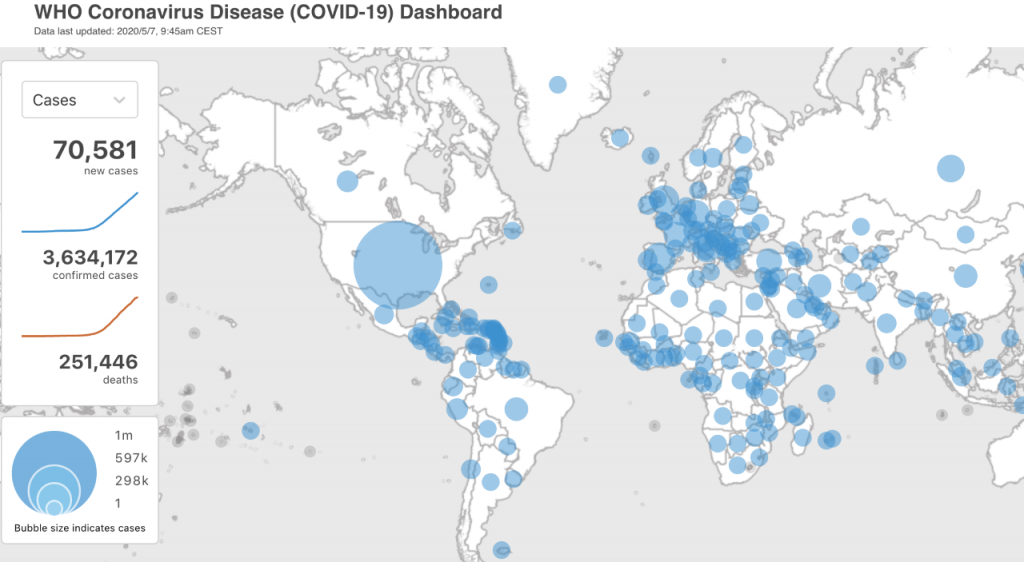Guest post by Dr. Claire Melamed, CEO of the Global Partnership for Sustainable Development Data.
Most of the time data is a boring backdrop to the real stuff that people care about: will my child get into university with those grades? Which party is likely to win at the next election? Who will win the World Cup? Most people are not usually rapacious consumers of data visualizations and statistics.
But the COVID-19 crisis has put data at the centre – we’re all experts now. Real-time data and testing is the only key to safely re-emerging from lockdowns, and we can’t look away from the grim daily tallies of illness and death. What has this spotlight taught us about how to build a better data system?
Invest in the basics
The last few months have revealed some pretty glaring deficiencies in data systems around the world, and probably the biggest is the shocking lack of good and consistent systems in many countries for measuring causes of death – arguably the most basic health indicator of all.

Given the billions that have been poured into health programs around the world over many years, it should be a matter of global shame that the causes of more than half of all deaths in the world still go unrecorded each year. No country has covered itself with glory here, but a good place to start would be investing in low-income countries, none of which have good quality death registration systems, according to the World Health Organisation.
The world after COVID needs to solve this problem. Donors could make a start by putting a percentage of their health spend into building the systems that consistently and reliably produce the data that underpins all policy and programming for global health.
Keep people’s interest
The insatiable global appetite for data and the sophisticated debates over the quality of that data has been remarkable to observe. It seems reports of the death of facts and experts were greatly exaggerated. It is absolutely possible for the public to understand and evaluate data – whether that’s comparing infection rates between countries, between rich and poor, or between young and old – and use it to hold policy makers accountable.
People are, of course, hungry for facts about coronavirus in a way that maybe they haven’t always been for details of, say, the attainment gap for poor and rich school students. But we know now that it’s possible to communicate data in a way that cuts through – and this should inspire hope among those who believe in evidence-based public debates.
Hopefully the world after COVID-19 will involve more and more civil society activists building on that interest in data to build the demand for evidence-based policy in all areas.
Trust the public!
COVID-19 data is complex and a moving target. Figures are updated daily, with revisions made to numbers that were released maybe days or weeks ago. The figures are partial as they only reflect how many people have been tested, and even the reliability of the tests themselves isn’t 100%. But statistics offices keep on going – releasing data that is still a work in progress, and trusting that it’s better to release good-enough data now, than perfect data after decisions have been made. There’s often a fear among statisticians of letting people in too early, and misleading people or looking foolish by releasing numbers that are updated later. But COVID-19 has shown that it’s possible, and useful, to trust the public to understand that numbers are a complex thing.
Hopefully the world after COVID-19 will make us all better consumers of data, and encourage governments to be more open with the numbers they use to make policy.
Move from debating data privacy to doing something about it
The discussion about contact tracing apps, how they are built, and the implications for personal privacy, suddenly makes data privacy everyone’s business. Like every debate about data privacy, it’s a question of trade-offs between benefits and risks. The response from the authorities hasn’t always been what you might hope, but what coronavirus shows is that people themselves are more than capable of having the discussion in a reasoned and transparent way.
Data campaigners after COVID-19 need to apply pressure on governments and multilaterals to rise to the challenge and accelerate progress towards new rules to protect us all.
Use data to make decisions
Data is useless unless it’s used. Everything above is pointless unless governments actually want to use all this data to make decisions. And the last few years have been, ahem, challenging ones for those who think big decisions are best made using good evidence.
So better data after COVID-19 isn’t about any one thing. It’s a slow incremental process of creating a system, based on good law and respect for rights, fully embedded into political cultures and expectations, attuned to market realities, and trusted by the public.
Two levers can help to build those systems: effective advocacy (governments have to want to do it) and good examples of how to do it (they need to know how). That’s what the Global Partnership was created for, and that’s what we’re doing, little by little, around the world.
We all want to see a better world coming out of the heartache and destruction that COVID-19 is bringing in its wake. Let’s hope we build back from this crisis to create fairer societies, and the systems for evidence-based policy to underpin them.